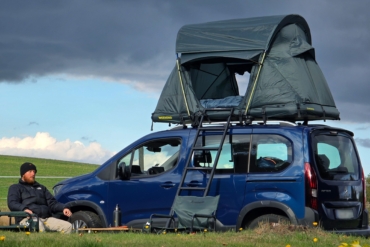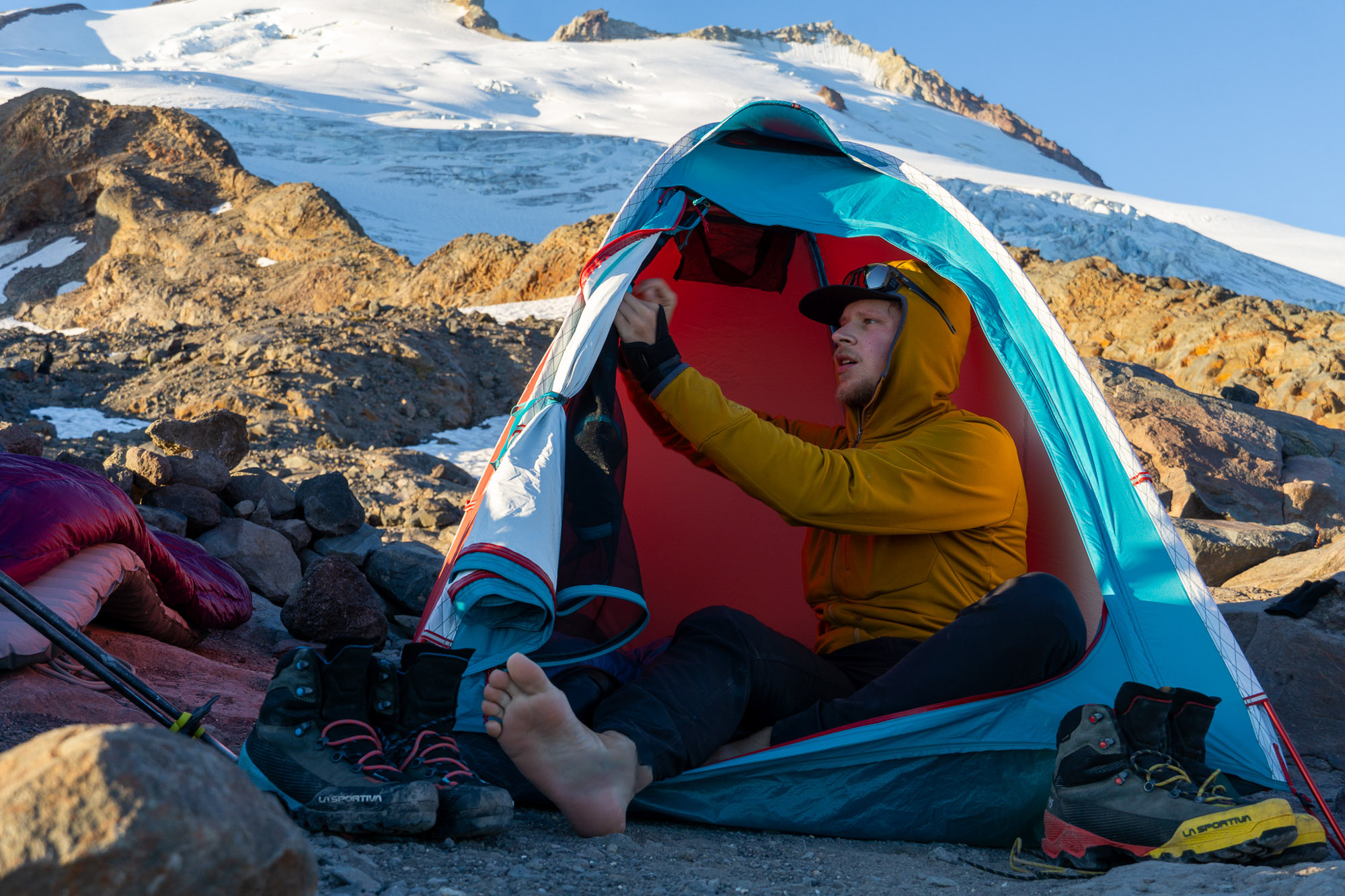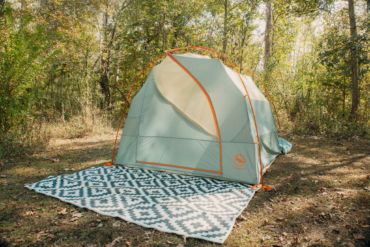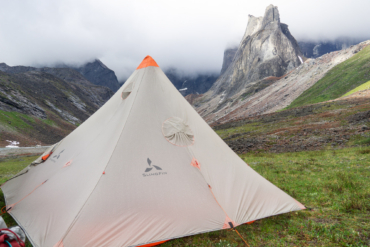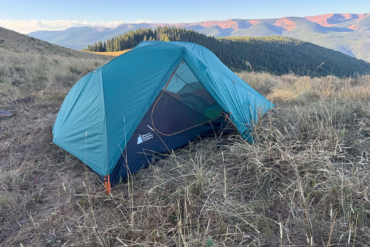Dyneema composite fabric and carbon poles help attain a one-pound trail weight — but at an extreme cost.
Big Agnes released the Fly Creek HV1 Carbon in 2019, touting it as the lightest single-person, double-wall, freestanding tent in existence. Big Agnes utilizes Dyneema Composite Fabrics and Easton carbon fiber poles to help achieve the gossamer weight.
But with an eye-watering price of $800 and questionable durability, who does Big Agnes expect to buy it? We’ve been testing the Fly Creek HV1 Carbon for 3 months trying to decipher the appeal of this unique offering.
In short: The Big Agnes Fly Creek HV1 Carbon entices the weight-conscious and highly experienced three-season backpacker who prefers double-wall freestanding designs and appreciates high-end materials.
The weight advantage comes with caveats, though: Handling with care is a must, interior space is limited, and the price is astronomical for a single-person tent.
Materials Steal the Show
Big Agnes draws the attention of the tech-oriented with Dyneema and carbon. The floor and rainfly are lightweight Dyneema, which has the advantages of low stretch, high tear strength, inherent waterproofness, and greater UV resistance. Dyneema is also weldable, eliminating seam tape and the resultant bulk and weight.
The single Easton 8.7mm carbon fiber pole employs an aluminum hub to join its three sections into the popular Fly Creek configuration. The pole doesn’t support the back two corners of the tent, so I consider the Fly Creek series semifreestanding.
It’s possible to use the tent without staking the back corners. But doing so greatly compromises the interior volume, and the inner tent drapes on the sleeping bag, possibly wetting it with condensation.
Big Agnes uses ripstop nylon for the tent body canopy, a departure from the mesh of most of the Fly Creek lineup.
It’s Light!
The Big Agnes Fly Creek HV1 Carbon in packaged format had a verified weight of 1 pound 7 ounces and measures 5 x 18 inches. The weight includes the tent, poles, 11 stakes, guy lines, and three stuff sacks. Tent, poles, stakes, and guy lines had a verified weight of 1 pound 5 ounces. A “trail weight” configuration of the tent, guy lines, and poles hit the magical verified mark of one pound even.
It’s also possible to use the Fly Creek HV1 in Fast Fly mode, which calls for the fly, stakes, poles, and footprint. This configuration comes in at a verified weight of 1 pound 1 ounce. (It’s worth noting that all the weights published by Big Agnes matched my verified numbers.)
Big Agnes Fly Creek HV1 Carbon Field Testing
Erecting the Fly Creek HV1 Carbon was familiar; I choose tents in the Fly Creek series when keeping packed weight down is a priority. The single-pole design and color coding kept setup easy unless the winds were raging, which was the case at an exposed sea cliff facing the Pacific in Baja California.
Only a diving catch prevented the fly from blowing into the ocean. I eventually asked for another set of hands! But in anything other than severe conditions, the Fly Creek series has never presented setup issues.
The raging winds continued through the night, and light precipitation, ocean mist, and lows into the 40s added challenges for the flyweight tent. I deployed all 11 tent stakes (I used sand stakes on beaches), and other than the fly periodically touching the canopy, the Fly Creek HV1 Carbon held steadfast through gusts of an estimated 25-plus mph.
No water made its way into the interior of the tent. My shoes also remained dry in the 5-square-foot vestibule. The Dyneema fly resisted the usual temperature/moisture-induced sagging of nylon; the fly doesn’t have the initial tension of multiple pole designs, so the dimensional stability of the Dyneema was even more appreciated.
Double-Wall Design, Interior Space
A big advantage of ultralight double-wall design is improved condensation control compared to single-wall cousins. Humid conditions on secluded beaches produced much more condensation than mesh canopies. It was enough to see small droplets on the interior surface, but not enough to drip onto my quilt. I felt condensation control was still much better than any of my single-wall tents.
There’s no way around it: The 19 available square feet of floor space, single door, and 39-inch interior high point make for cramped living. Doing anything other than lying down without contacting the inner walls was an exercise in body awareness. And that could be a factor if frigid temperatures demand keeping insulation dry.
One curious design element of Fly Creek tents is the steeply sloping ridgeline; the pole continues in a high arc, but it suspends the canopy well below. This design element seemed like a huge loss of interior space for little gain.
Other features that I appreciated are three interior mesh pockets, gear loft loops (optional loft MSRP $22), guy line tensioners, reflective guy lines and webbing, and substantial zipper pulls.
What About Durability?
The Fly Creek HV1 Carbon did require careful handling, which Big Agnes stated in all its marketing. The brand suggested this tent for only the most experienced users.
The Dyneema was extremely resistant to physical assaults other than abrasion. During a hurried packing job, I shoved the tent pole into the main Dyneema stuff sack. The metal ferrule edge produced a one-inch-long cut. Big Agnes supplied repair tape with the tent, a nod towards its understanding of what could happen.
Big Agnes PR also suggested and supplied a tent footprint ($70 MSRP, 3 ounces) for any site where the Dyneema floor might be compromised. During a 6-day trip in Baja, the only time I didn’t use it was when camped on sand. The footprint did add weight, but the total package was still extremely light.
Although the carbon poles proved their mettle during the testing period, my experience with ultralight carbon components is mixed. I’ve had carbon parts crack from incidental mistreatment like stepping on hollow ends or impact.
But I don’t think the Easton carbon poles supplied with the HV1 Carbon would fail under the stresses of supporting the tent in all but the most extreme (and inappropriate for this tent) conditions.
Other than using the footprint, I practiced extreme care in choosing the tent site and during setup and takedown to avoid anything that could cut or puncture the Dyneema. After I set up the tent, I used it just as I would any other tent. And other than the stuff sack incident, the tent went undamaged.
Conclusions
I think the target market for the Fly Creek HV1 Carbon understands the limitations of Dyneema and carbon, would apply appropriate care without complaint, and would also accept the limited interior volume. For these users, the biggest hurdle is the $800 price.
Cottage industry single-wall trekking pole Dyneema tents, like the Zpacks Duplex (MSRP $599, available as a freestanding version at $725) or the Tarptent Aeon Li (MSRP $535), can be less expensive. But, they can weigh about the same or more, even without the weight of tent poles, and most aren’t freestanding.
The Big Agnes Fly Creek HV1 Carbon may appeal to a very narrow segment of ultralight experts. They demand the lightest double-wall freestanding tent, appreciate and understand the advantages and limitations of exotic materials, and are willing to pay a premium for said attributes.
Until the price drops on Fly Creek HV1 Carbon, this sliver of the market may represent the only viable customer for Big Agnes. But I think the brand had this in mind all along. And, at the very least, it has made quite a statement with this showcase product.







